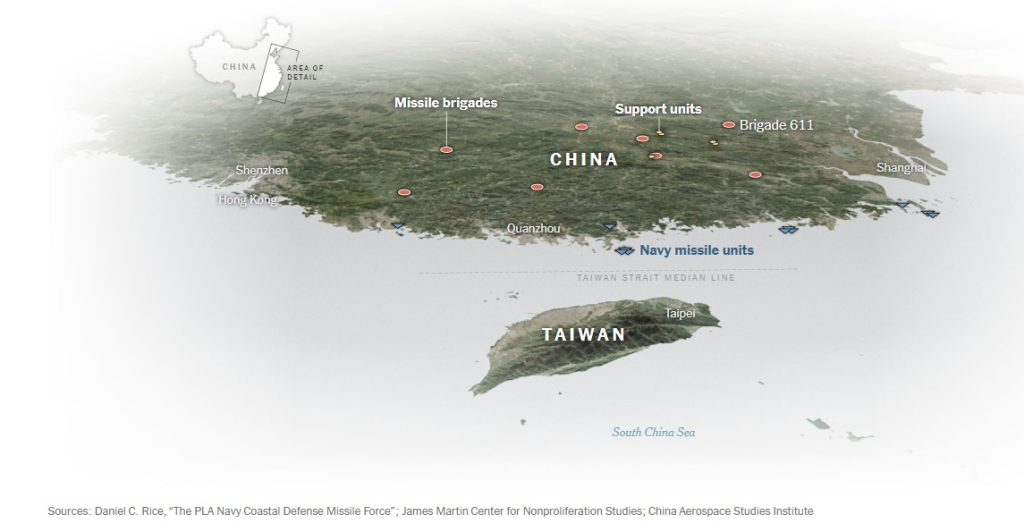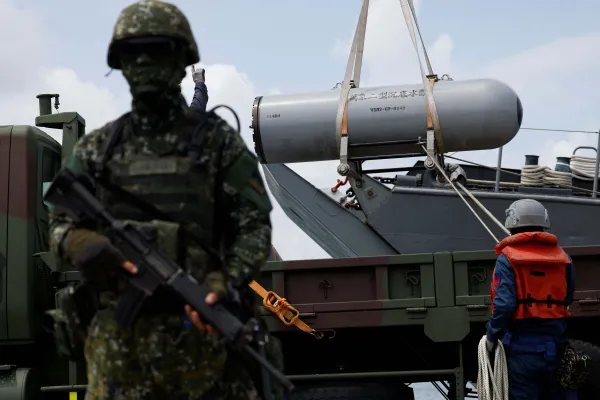美军在吕宋海峡秘密部署地对舰拦截导弹
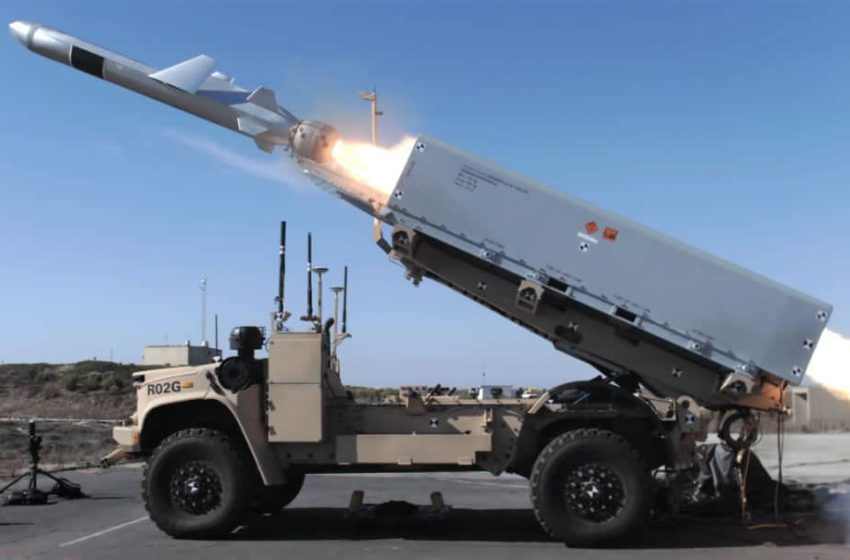
5月25日《华尔街日报》爆料称,美国海军陆战队在菲律宾巴坦群岛秘密部署了一种名叫“复仇女神”(Nmesis)的导弹系统,旨在威慑中国军舰。
从地理位置看,巴坦群岛处于菲律宾北部吕宋岛和台湾之间“吕宋海峡”(又称“巴士海峡”)的正中央。该海峡是联通中国南海和太平洋之间的重要国际水道,也是西太平洋具有重要战略意义的海域之一,船只往来非常频繁。海峡平均宽度约185公里,水深一般在2,000至5,000米之间,最深处达5,126米。
根据美国海军陆战队发布的新闻稿,美军将数套“复仇女神”发射器从菲律宾北吕宋岛运送到巴旦群岛的多个岛屿,这将成为美军和菲律宾海军陆战队的火力远征前进基地。
美国军方近期在菲律宾部署了包括能发射“战斧”巡航导弹的“台风”导弹发射器,以及能够快速打击目标的“标准-6”导弹。这两种导弹的射程更远,但是它们的部署位置不如“复仇女神”导弹防御系统及其“海军打击导弹”(NSM)那样靠前,这两种导弹也不像NSM那样专注于反舰和海上控制行动。
“复仇女神”是一套无人驾驶车辆和发射器的组合,发射器内装有两枚随时可以发射的NSM导弹。一个海军陆战队小队的操作人员在两辆支援车辆上进行远程操作,这些支援车辆位于任何试图摧毁发射器的人员的火力范围之外。
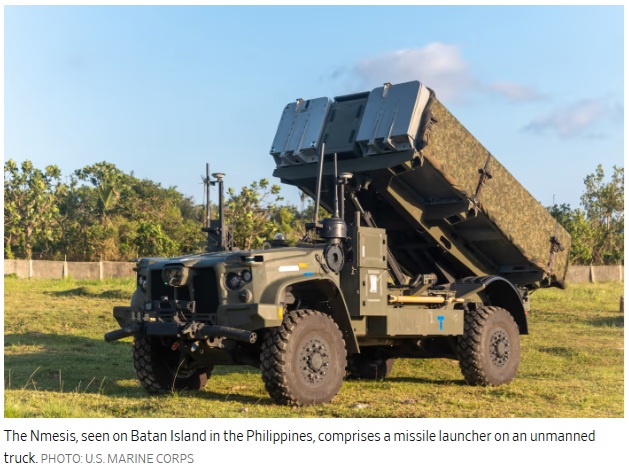
该系统可以快速部署,并能够在条件恶劣的区域进行高度分散的作战。海军陆战小队负责监视分散在区域内的发射器,并定期移动它们,以防止它们成为敌方目标。
MSN导弹由挪威康斯博格防务公司设计,由该公司与雷神公司(Raytheon)合作为美国生产。该导弹具有隐身特性,有助于提高其生存能力。它还使用红外成像导引头进行末端标准。该导弹本身不发射雷达视频(RF)能量,而是使用被动射频探测措施,以迅雷不及掩耳之势飞向目标而不会惊动敌人。每枚导弹的成本约190万美元。
鉴于NSM的基线射程约为110海里,巴坦群岛或许是最佳部署地点。由于它位于海峡中心的岛屿位置,它能够对任何从台湾海峡南端到菲律宾吕宋岛北部,以及东西方向100海里范围内的船只造成威胁。这正是该系统以及新组建的海军陆战队濒海战斗团的设计初衷。
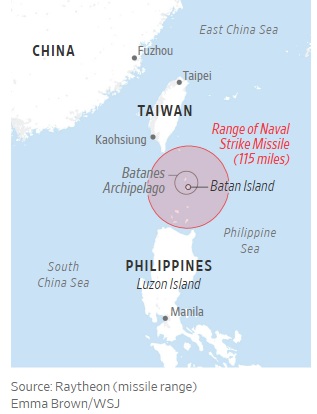
U.S. Aims to Keep Chinese Navy Guessing With New Missile System
As China dominates swaths of the Pacific, the U.S. is looking for ways to push back. The Nmesis is a key part of that.
By Gabriele Steinhauser, Wall Street Journal, May 25, 2025
Key Points
- U.S. Marines deployed a Nmesis missile system to Batan Island, Philippines.
- Nmesis is an antiship missile launcher on a remote-controlled truck, designed to deter Chinese warships.
- The Philippines is key to a broader overhaul meant to make the Marines more agile.
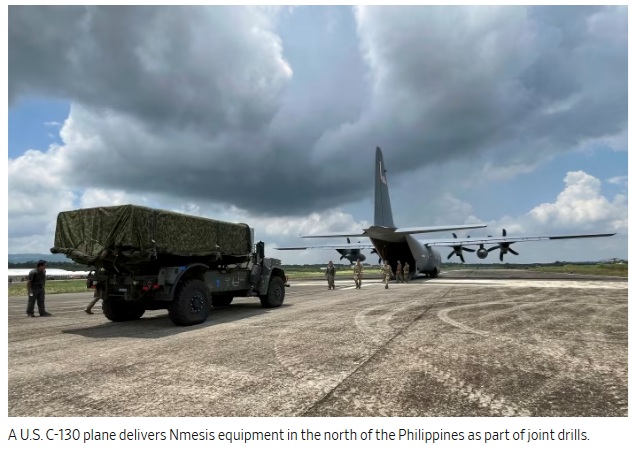
BATAN ISLAND, Philippines—The Air Force C-130 transport plane dipped down on the sun-baked airfield of this remote island in the northern Philippines, delivering a weapon system designed to give the U.S. an edge in the intensifying superpower standoff in the Pacific.
The Navy-Marine Expeditionary Ship Interdiction System, or Nmesis, is an antiship missile launcher mounted on a remote-controlled truck. The dumbbell-shaped islet where it landed lies just 120 miles south of Taiwan.
For the Marines, the Nmesis’s flight to Batan was a key test in a high-stakes retooling aimed at readying the military’s rapid-response force for a war with China in some of the world’s most strategic, but increasingly tense, waterways.
The prospect of an armed conflict with China—whether over Taiwan, the self-governed democracy Beijing claims as its own, or the contested shipping lanes of the South China Sea—has the U.S. playing catch-up. While American forces were bogged down in Iraq and Afghanistan, China built up the world’s biggest navy and a formidable arsenal of missiles aimed at making swaths of the Pacific off-limits to its adversaries.
The Nmesis—pronounced “nemesis”—was designed to erode that lead. It takes advantage of natural chokepoints like Batan to raise the cost of access for Chinese warships. Initially built to be launched from ships, the Norway-made Naval Strike Missiles the Nmesis fires can sink vessels some 115 miles away, skimming the water and adjusting their trajectory to follow and hit a moving target.
With the Nmesis, Marines can now shoot these high-precision missiles from land, including from remote, mountainous islands like Batan, where launchers are far easier to conceal than on the open water. The main vehicle carrying the missiles is unmanned. Its operators work from a distance, based in two support vehicles that place them outside the line of fire of anyone trying to take out the launchers.
The Nmesis’ mere presence on strategic islands in the Pacific complicates decision-making for adversaries, who have to weigh the threat it poses for any vessel that may find itself within striking distance, said Col. John Lehane, the commander of the Hawaii-based Marine regiment that deployed the system to Batan late last month as part of an annual exercise.
“Once you put it on the ground, it is there. It can move around. It is hard to find,” Lehane said.
The Nmesis’s antiship capabilities give it an edge over other land-based missile systems, such as the M142 High Mobility Artillery Rocket System, or Himars, which helped transform the battlefield in Ukraine but has struggled to hit moving targets at sea, Lehane said.
Rommel Ong, a former vice commander of the Philippine navy and now a senior research fellow at the Ateneo School of Government in Manila, likened the Nmesis’ presence on islands in the Western Pacific islands to a “shell game.”
“You keep the other side guessing and that creates the uncertainty and in a way that creates the deterrent effect,” he said.
Lehane’s 3rd Marine Littoral Regiment was the first Marine unit to take delivery of the new system late last year. The Nmesis is a centerpiece of a broader overhaul of the Marines aimed at making the force more agile, able to swoop into action even after a conflict has already erupted.
The Philippines, America’s oldest treaty ally in Asia, is a key part of that new push. The government of President Ferdinand Marcos Jr. has given the U.S. military access to more bases, on which it can build facilities, pre-position equipment and refuel and maintain aircraft and vessels.
Since the U.S. has no permanent troops based in the Philippines, Washington would have to airlift fighters and weapons to small, hard-to-access islands, under the threat of enemy fire.
Extensive drills mean some U.S. troops now rotate through Philippine bases for much of the year. That not only improves coordination with the Armed Forces of the Philippines, but also allows Marines and Air Force pilots to get more familiar with the topography of the Pacific theater. On practice flights and reconnaissance missions, they scope out mountains and other features that could serve as cover.
“We get really low and hide,” said Capt. Benjamin Dorsey of the 39th Airlift Squadron, which moved the Nmesis to Batan.
Lehane said the successful deployment of the Nmesis should signal to potential adversaries that the Marines’ island fighters are ready for combat.
“A lot of folks are still perceiving our unit as experimental and it’s absolutely not experimental,” he said. “The most important thing is to get folks accustomed to the fact that where you see 3rd Marine Littoral Regiment, you should expect that there are Nmesis with us.”
作者
-

作者为北美知名时政评论人、本站特约专栏作家。


